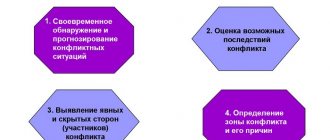We are all different. And we are talking not only about the external data that nature gave us. We differ from each other in behavior, reactions to certain situations, characteristics of interaction with society, mentality, etc. Human development has long been the object of study by psychologists and scientists. As a result of observations of people that have been going on since ancient times, various psychological typologies of personality have emerged.
They say that if you understand typologies, you can make your life a lot easier: firstly, you will understand yourself, your characteristics, strengths and weaknesses; secondly, at a minimum, learn to interact effectively with people. Is this really so and what personality typologies will help “reveal all the cards” of a person, we will tell you in this article.
Welcome to the world of amazing people!
Classification of people by temperament
Few people know that the founder of the definition of personality types is the famous ancient Greek physician and philosopher Hippocrates. Being a leading doctor of his time, he conducted many interesting experiments.
Since Hippocrates was a supporter of materialism, he tried to find a connection between temperament and the amount of one of 4 fluids in the body: lymph, blood, yellow and black bile.
As a result, he introduced 4 main types of temperament:
- choleric;
- phlegmatic person;
- melancholic;
- sanguine
According to Hippocrates, yellow bile predominated in the body of choleric people, black bile - of melancholic people, lymph - of phlegmatic people, and blood - of sanguine people.
For obvious reasons, modern medicine cannot take seriously these conclusions of the famous ancient Greek doctor, who did not leave behind any explanation as to how he managed to identify such patterns.
An interesting fact is that Hippocrates compared a person’s character with his physical health. He believed that in our body thoughts, the state of organs and emotions are inextricably linked.
In modern medicine and psychology there is such a direction as psychosomatics. Psychosomatics (“psyche” - soul and “soma” - body) studies the influence of psychological factors on the occurrence and course of somatic (bodily) diseases. By approaching this issue correctly, many people have managed to get rid of various ailments associated with psychosomatics.
Example 1: how to buy a camera
Let's now look at the clear example of buying a camera, how people behave with various radicals.
Schizoid
He is interested in technical characteristics, functionality, the number of defective returns, and selects a camera to suit his needs and tasks, in order to fit into the budget. Looking for the best option. It may go beyond the budget, but only if there is a strong justification for this and new information that the schizoid did not take into account before. He is very afraid of wasting money and getting a problem item.
How to convince:
- Show that this is the best option, and there is no better one.
- Show reliability and quality.
- Show the guarantee to finally reassure.
Neurotic
He is interested in how many people have already bought the camera, what are the reviews, who among the authorities uses the camera, does it make an impression on people, what brand of the camera is it - a well-known brand or not.
How to convince:
- Show that this is a bestseller.
- Show reviews from people who bought.
- Tell them that this camera is used by authorities.
- Show the status and authority of the brand.
- Make adjustments to the seller, say that he has the same one, and he is very pleased with it, tell a story.
Hysteroid
They’re not particularly interested, but they put on a show: “Oh, I don’t even know which camera to choose. What advice would you give me so that everyone is buzzing about me on social networks?” They will buy what “they deserve.” Especially if it's exclusive.
How to convince:
- Make a compliment.
- Show a visual, engaging demonstration.
- Engage emotionally.
- Show exclusivity.
Temperament types
Let's briefly look at each type of temperament and give it the corresponding characteristics.
Melancholic people
Of the 4 personality types, melancholic people are the “weakest”. They have weakly expressed inhibitory and excitatory processes, which makes them very sensitive.
Even something insignificant can cause melancholic people to worry. They are often depressed and more prone to depression. Among them you can often find neurasthenics who carefully hide their emotions.
For this reason, melancholic people may develop mental and nervous disorders, which in turn can cause diseases of the stomach, cardiovascular system, and liver.
Cholerics
Cholerics by nature are the complete opposite of melancholics. They are distinguished by an unbalanced and firm character.
An interesting fact is that people with this personality type are more likely than others to suffer from liver and gall bladder diseases. It is difficult for them to control their emotions, as a result of which they are characterized by irritability, outbursts of anger and often rage.
As a rule, choleric people have difficulty getting along with people. They are very impulsive, fussy and lively in conversations with their interlocutor.
Sanguines
Sanguine people are the most “lively” personality type. They are strong, balanced, active and often take the initiative. As a rule, sanguine people are inclined to work, as a result of which they are afraid of not being able to do something or making a mistake.
They are demanding not only of themselves, but also of others, which sometimes leads them to stress or depression.
People with this personality type most often suffer from diseases of the cardiovascular system. They are also susceptible to strokes and heart attacks.
Phlegmatic people
Phlegmatic people belong to the “calm” personality type. They are distinguished by prudence and balance. It is very difficult to piss them off.
This type of personality is not difficult to identify in a crowd of people: in the process of any unrest or general panic, they remain calm and try to stay away from the events taking place.
Phlegmatic people prefer not to get upset over trifles, trying not to take everything to heart. Despite this, they are the ones who suffer from stomach ulcers more often than other types.
Read more about temperament types here.
So why do we need all this?
Today there are so many personality typologies that you involuntarily begin to doubt whether you need to bother yourself with them? The answer is clear – of course you need it! But just don’t score, but at least show interest in them.
First of all, the ability to understand psychotypes is useful for ourselves. If a person understands what type of personality he is, he will know his strengths and weaknesses, which means he will be able to competently manage them. This is a way to discover new opportunities for yourself, because often people tend to follow stereotypes or advice rather than listen to their own nature.
This is the case when a born speaker goes to work as an accountant, because, as his mother said, he will always have some money. As a result, no pleasure from work, no energy and no future prospects.
Cholerics, for example, make good bosses. They can handle any job that requires a lot of energy: journalist, coach, teacher, etc. Sanguine people easily find companionship, they can lead people, and they have good organizational skills. Phlegmatic people are strong in precise disciplines, while melancholic people are hard workers who love to work alone and require attention to detail.
As you can see, knowledge of the fundamental typology of Hippocrates’ personality already gives an understanding of what’s what. Now imagine what will happen if a sanguine person is seated at the mathematician’s table, and even alone?
Almost all HR specialists use various methods for assessing personality typology in their work. This is necessary both in personnel selection and in personnel changes, because an employee’s good results in an ordinary position do not always indicate that he will be an excellent leader; perhaps he lacks a natural manager, so a comprehensive assessment of personnel is important.
Surely, each of us has friends with whom we just can’t find a common language, or even some we consider, as they say, “not of this world.” There may be a conflict and misunderstanding with someone, because often people who are accustomed to being open with others, sociable and energetic perceive the slowness or isolation of their interlocutor, friend or colleague, as a kind of challenge, a negative personal attitude, which, naturally, is a mistake .
It is important to understand that there are no bad personality types, there are people with their own characteristics of character and behavior that are inherent to them by nature. It is the ability to assess a psychotype that helps to find a common language with others, prevent and resolve conflicts, and even agree on something.
And it is also important to understand that there are personality types that, in tandem, provide maximum or minimum productivity. If we look at the example of the DISC model, “red” interact best with “yellow”, but it is better not to pair them with “blue”, because These are two diametrically opposed personalities.
If you correctly consider the information about what type of personality your interlocutor (relative, colleague) belongs to, you can easily find the necessary levers to achieve maximum efficiency in communication. For example, with “yellows” you need to be positive in your communication, more often interested in their opinions, and to argue your point of view, refer to the views of authoritative individuals. You shouldn’t talk only about business with the “greens”. Informal communication is best suited to resolve various issues [O. Knysh, 2019].
Moreover, according to some psychologists, each personality type has its own illnesses. More precisely, if some character trait of a person is exaggerated or, conversely, strengthened, then mental abnormalities may appear. This relationship is clearly shown by the “7 radicals” personality assessment method, where all the names of radicals are derived from the names of diseases: schizoid, epileptoid, hysterical, hyperthymic, paranoid, emotive, anxious [V. Ponomarenko, 2006].
We are all individual and have our own set of personal qualities and character traits, which means that each person needs different approaches to communication, and if we are talking about children, then based on the child’s personality type, it is possible and necessary to build an individual education system.
If you find it difficult to determine on your own which personality type is dominant and which are auxiliary, and also cannot sensibly assess your strengths and weaknesses, we advise you to follow this useful link and discover the wonderful world of self-knowledge.
Social personality types
In sociology, personality types are related to historical, economic, social and cultural events that directly influence them.
Here, as in psychology, you can find a variety of personality types. According to Max Werber, people must be divided according to their degree of rationality.
Taking this factor into account, there are two personality types:
- rationalists;
- irrationalists.
In turn, Erich Fromm suggests dividing people into 3 types:
- receptive (passive) – ready to obey others;
- exploitative - those who take advantage of other people's labor;
- accumulators – prone to market relations.
Sociology divides people into the following types of personalities:
- traditionalists;
- realists;
- idealists;
- hedonists;
- frustrated type.
Traditionalists tend to be orderly and disciplined. They try to live by the law and do not strive for self-improvement.
In contrast to them, realists, on the contrary, try to realize themselves in life. In addition, they try to keep their emotions under control and not fall into hysterics.
Idealists include those who strive for independence and fight against established rules.
Hedonists are not at all interested in what is happening in society. Most of all, they want to receive satisfaction from life, which manifests itself in material values and sensual pleasures.
A frustrated personality type is characterized by low self-esteem. They feel superfluous in society, as a result of which such people often become outcasts or homeless.
Summarize
Each personality combines unique patterns of behavior, ways of perceiving the world, and a certain reaction to events. Among us there are no “pure” representatives of a certain typology; we combine various character traits that were given to us from birth or acquired in the process of life.
It’s amazing how carefully the ancient knowledge about human personality types is passed on from generation to generation to this day, despite constant changes in the outside world. They help us understand ourselves, our strengths and weaknesses, opportunities and prospects, and a detailed study of a specific personality type helps us understand the intricacies of communication, methods of persuasion, and even methods of resolving conflicts.
Knowledge of personality typologies and the ability to correctly evaluate people radically change the picture of the world: now what previously seemed strange is perceived as nothing more than a property of a certain human psychotype. Today you don’t need to be a born psychologist and know all the characteristics of personality typologies by heart; just take several online tests to determine your psychotype, and you will receive a detailed description of your “I” and recommendations.
We wish you good luck and suggest answering the question on the topic of the article:
Personality types in socionics
In the 1970s, based on Jung's typology and Kempinski's theory of information metabolism, socionics arose - a new concept of personality types and the relationships between them.
In socionics, personality types are considered depending on how the following characteristics are combined in an individual:
- introversion and extroversion;
- logic and ethics;
- rationality and irrationality;
- sensory and intuition.
Let's briefly consider socionic personality types.
INTROVERTS – the driving force is self-interest. These are closed individuals with communication problems, completely focused on their inner world. Characterized by an inward orientation of life.
EXTROVERTS – the driving force is external factors. Extroverts are open and ready to communicate people who are not always capable of independence. Characterized by an outward direction of life. Read more about extroverts and introverts here.
LOGICIANS rely on logical thinking, which helps them arrive at the truth.
ETHICISTS adhere to traditional moral norms and concepts. People with this personality type are keenly interested in art and creativity.
RATIONALISTS put reason in the first place with principles and traditions established in society.
IRRATIONALISTS try to improve themselves and constantly strive for innovation. They are characterized by unconventional thinking and creativity.
SENSORS try to process information not in time, but in space. They consider it important to experience sensations. They are interested in art and the beauty of nature. Sensors pay attention to events occurring at the present time, but they care little about the future.
INTUITS prefer to get acquainted with different information in accordance with time, and only then watch how events will develop. People of this type are absent-minded and do not strive for improvement.
List of qualities
Personality structure includes temperament, volitional qualities, abilities, character, emotions, social attitudes and motivation. And also separately the following qualities:
- Independence;
- Intellectual self-improvement;
- Communication skills;
- Kindness;
- Hard work;
- Honesty;
- Determination;
- Responsibility;
- Respect;
- Confidence;
- Discipline;
- Humanity;
- Mercy;
- Curiosity;
- Objectivity.
A person’s personal qualities consist of internal perception and external manifestations. External manifestation includes a list of indicators:
- innate or acquired artistry;
- attractive appearance and sense of style;
- oratory skills and clear pronunciation of speech;
- a competent and sophisticated approach to non-verbal communication.
The main qualities of a person (her inner world) can be classified according to a number of characteristics:
- a comprehensive assessment of the situation and the absence of conflicting perceptions of information;
- an inherent love for people;
- open-minded thinking;
- positive form of perception;
- wise judgment.
The level of these indicators determines the individual characteristics of the individual being studied.
Example 2: speaking to investors
In the second example, imagine that you have your own project and you need to speak to investors. Different types of investors respond better to different aspects.
What is important for schizoids
- Business plan including numbers, calculations and forecasts
- Viability Case
- MVP (minimum viable product) - product prototype
- Certificate of competence
What is important for neurotics
- Social significance, what problems and what audience the project solves
- Influencer Support
- Social proof
- Portfolio status
- Personal sympathy, strong first impression
What is important for hysteroids
- Championship
- Exclusivity
- Bypassing competitors
- Emotional involvement
- Prospects
At the same time, it is important to remember that since we do not know what types we are working with, and also given that in every person there are manifestations of all three instincts, it is ideal to focus on all three aspects in combination. Then we are highly likely to meet the interests of our target audience.
Example 3: selling oranges
Now let's look at selling something simple. For example, oranges. What should you tell people in this case? You can’t say right off the bat... Well, that it’s sweet, tasty, juicy... But once we divide the audience by radicals, then everything becomes clear and understandable, look.
For a schizoid:
- 100% safe and natural: no nitrates or pesticides
- Content of useful vitamins and microelements
- Guarantees of hand picking, integrity of fruits without rot
- Competent storage and transportation system
For a neurotic:
- The heartwarming story of a plantation founder
- Brand and its status
- Social proof and authority: who buys oranges
- Social and ideological aspect, for example, in the context of charity
For the hysteroid:
- Elitism
- Benefits for beauty and attractiveness
- Unavailability or limited quantity (shortage)
- Visual demonstration
Do you see? It is much easier to determine priorities by importance, and then, for example, in the text, we simply build benefits for each type and combine them into a separate block. This way we are more likely to meet the interests of our target audience.










